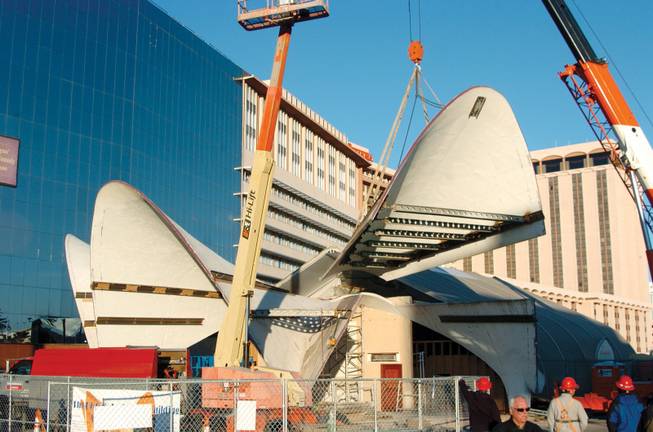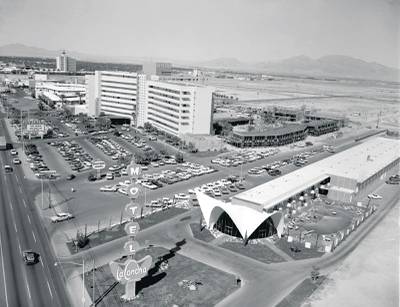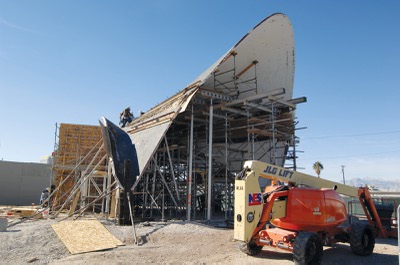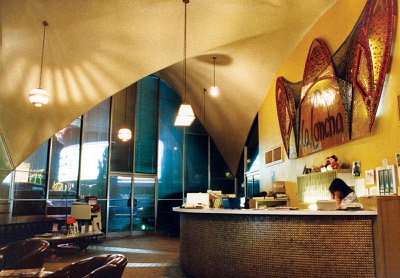
Courtesy of the Las Vegas News Bureau
Disassembly of La Concha. December 19, 2006.
Thursday, Dec. 11, 2008 | midnight
A tall, skinny cowboy in snug jeans is looking across the vacant lot south of the Riviera, and he spits.
“Oh yeah, I do remember. ... The clamshell,” he says, tugging on the brim of his black hat. “[They] blew it up, I guess.”
In fact, the clamshell was not blown up, nor has this property been turned into the posh condos the owners originally had planned when La Concha was closed (2003) and removed (2006). A nearby booth where show tickets are hawked stands in front of the fenced-off parcel, adjacent to a tourist shack selling discount Grand Canyon tours.
The clamshell—La Concha Motel’s famously shell-shaped lobby—has been hauled off, awaiting a new incarnation as a visitor’s center for the Neon Museum. At long last, the city of Las Vegas announced last week that the Federal Highway Administration will grant $800,000—on top of private donations and other grants—to help preserve it. This came as grand news in a noteworthy preservation campaign that has tested a community so accustomed to implosion and replacement. “What that $800,000 does is ensure the success of the La Concha project,” Bill Marion, Neon Museum board member, says.
The lobby will spearhead a planned scenic byway on the Boulevard just north of Bonanza—a wide spot in the median with vintage signs and trees leading to the forthcoming Neon Museum. Renovation of the lobby and construction of administration offices is estimated to cost $1.5 million; it cost $600,000 to cut the lobby into eight pieces and move it off of this site for reassembly.
“I wish I could’ve seen it blown up,” the cowboy says, refusing to hear my story of preservation. “I’ve never got here for one of those.” A middle-aged woman in pink hot pants walks past us; she’s drinking a Miller. In the distance, the cranes on the Strip’s construction sites hang in wait.
May 2008
The La Concha sits on the side of the Boulevard behind a green-tarp-covered fence, her shell arches reaching up to an empty sky. We’re touring the Neon Boneyard on a rare day when it’s open to the public without an appointment. It’s hot. Noon, May. Five bucks. The few dozen cars parked across this northern end of Las Vegas Boulevard, next to Cashman Center, have tags from all over: Delaware, Colorado, Utah. A woman and a dog leave from behind the fenced lot full of Vegas’ old signs; another woman with bright fuchsia hair is making her way in.
Restricted Area
Keep Out
Business cards stapled to a street post:
Sober Living For Men
Sober Living For Men
Sober Living For Men
And then the art-smart girl behind the table at the fence’s entrance says, “Welcome to the Boneyard.” There is graffiti on the curb and on the private property signs. We sign a paper saying we will not use our photos for fine art or commercial purposes.
Panorama By Zach Wise
Inside: chunks of history? The first thing we see is the old City Center Motel sign, which offers satisfying irony because of the CityCenter project going up right now—the mammoth, crane-infested hotel/condo project on the Strip signifying Vegas’ economic audacity.
Here, in this cramped dirt lot, where signs lay on their sides and backs, in pieces, with missing lightbulbs and plenty of rust, the old City Center sign is cute, quaint. It portrays a silhouette of a city and was designed by Betty Willis, who famously designed the “Welcome to Fabulous Las Vegas” sign, and never got a penny’s worth of royalties.
Visitors are getting sunburned. Tourists are shuffling around taking photos with the upended and aged signs as if in a national park with geological wonders, as if standing by the opening of the Grand Canyon or the eruption of Old Faithful. They’re dressed in sun hats and shorts, trying to figure out what each sign was, where each giant letter fits into history. We stand under the Aladdin’s lamp, and I feel like I should wish—but for what? For a time when things were as they once were? Or a time when Vegas valued its visual creations as art beyond their initial economic power?
Up ahead, in the corner, a 30-foot Mr. Lucky is flat on his back, burned from the inside out. He’s a giant leprechaun that used to wave in front of Fitzgerald’s, and then was retired to this boneyard in good health. But someone snuck past the fences at night and went into the door in his back, into his belly, and lit a fire. His chicken-wire and foam torso burst into flames.
More
- From the Archives
- La Concha crush (12/18/03)
- Beyond the Weekly
- La Concha photo gallery (Las Vegas Sun, 2/19/08)
- History on the move (Las Vegas Sun, 12/27/06)
- Powerful Lobbyists: Groups determined to save the heart of La Concha hotel (Las Vegas Sun, 8/18/05)
- Trying to save a bit of history (Las Vegas Sun, 7/15/05)
“We’re hoping he’s not past the point of restoration,” the guide says. “He may go back Downtown and be placed in the median.”
It’s like a massive theme park after a tornado, or an airplane crash. Pieces of the enormous signs lying on their sides and backs look like pieces of a fuselage strewn about catastrophically.
“Part of the magic of the Boneyard is seeing how gigantic they are in person when they come down off the building. And seeing how slapdash they are.” Chicken wire, flaking paint, chipped fiberglass.
There’s a House of Lords Steakhouse sign, defunct; and a Royale Motel sign sporting an image of a king’s hat, dethroned; and a sign with an image of a castle, wrecked. Thousands of busted lights, rusting filaments, dust, dirt, weather.
A woman says she drove all the way from Salt Lake City to see the Boneyard but had always envisioned it as something she would see at night, with the lights of all of the signs on, bright, the way they might have been in their youth. No, she is told. There isn’t the money for that, and much of the wiring is gone.
“Someone broke in and stole our copper wiring,” the guide says. She’s carrying an umbrella to shade her white skin from the sun. Preservation.
Behind this corner of McWilliams and Las Vegas Boulevard, behind the fenced lots of dead giants, are meager homes and apartments that have aged as much without notice. Apartment 4212’s balcony overlooks the vestiges of some of the most famous signs in Vegas history, but neither seems aware of the other.
When last I saw the La Concha, it was raining. We were standing on the Strip—both of us—and bulldozers were coming, and young men were planning to make more fortunes on her site. Today, she’s here at the Boneyard, but off-limits to visitors. We pass her by now, just that iconic lobby that was salvaged and set here, behind a fence, on a gamble that a little bit could be preserved.
December 2003
Under a Thunder From Down Under billboard, a red excavator—one of those big earth-moving machines with a giant, fanged scoop on it—is trashing La Concha Motel’s guest rooms. It started in the back. The two-story creme and mauve building is collapsing under the bites of the machine. It’s loud: Windows are crashing, lumber is popping, concrete blocks and stucco are crumbling, the excavator is roaring.
Tourists don’t seem to take note—they just keep strolling by on the Strip. Traffic to the Riviera next door doesn’t slow down. An older man, a snowbird resident in the nearby apartments, walks up, takes a gander and asks, “I wonder where all the hookers are going to go?” He’s been breakfasting across the parking lot at McDonald’s for years and says he’s made a sport of watching prostitutes leave La Concha at sunup. This questionable tribute aside, it appears that the flattening of an old Strip hotel isn’t much of a spectacle. In fact, La Concha’s front office is still open despite the back half of the building being annihilated: Rose is still answering calls to the front desk, and a gentleman is booking rental cars. A woman who seems somewhat jittery and strung out, dressed in a tank top and threadbare sweat pants that hang quite a bit lower than her red thong, fights with the vending machine. The car agent jokes, “We love this place so much, we’re going with it.”
La Concha was built in 1961. It was designed by famed Los Angeles architect Paul Revere Williams. The office interior is a throwback—there’s a brown vinyl couch whose arms are worn to the cotton and wood inside; an old gray refrigerated drinking fountain; worn red paisley carpet; and a tile mosaic that says La Concha on the bright green wall behind the front desk. It’s a little grungy and a lot intriguing. And it’s nearly history.
A few very well-dressed people begin to congregate outside—a woman in a black fur, a man with slick- backed hair wearing a full-length blue wool overcoat. Owner and developer Lorenzo Doumani, son of former Tropicana owner Ed Doumani, is there, in a black leather jacket. The excavator takes another bite; a bathtub tumbles out of the wreckage. The plan is to spare the office for another six months, to knock down just the hotel-room buildings right now, and then unveil the plans for whatever new Strip hot spot will be built here once the lot is wiped clean.
“It’s going to be turned into a very, very unique, upscale—well, we’ll be having a press conference in January,” Doumani says. “But let’s just say it’s going to change this end of the Strip.” Word is, it’ll be a 400-room hotel that will focus more on luxury than gambling.
The excavator crushes another 20-foot chunk of the old hotel. They’re getting pretty close now, two balconies away from the office.
Inside, Rose is finishing up some last-minute tidying at the front desk. Helga, another old-time worker, had gone to the nine-story tower at the back of the property to shoot last-minute photos, and she returns now, as the excavator is nearing the office, and she is in tears.
Rose says, “It’s always sad when renovation costs more than knocking it down.” A man comes into the office and starts laying white hotel towels over the desks to protect them from dust. A TV crew comes and takes a shot, goes. Finally, the excavator gets within 50 feet of the famous curvy, conch-shell architecture of the front office. Rock and dirt has spilled into the empty pool. A construction foreman comes through and says, “We don’t want anybody in the building now.”
Everyone goes outside. A light rain has begun to fall. The whole group takes refuge under the eave of the adjacent building, in front of a beauty salon and an Asian barbecue. Shopkeepers and restaurateurs come out to watch. The excavator bites into the last few rooms, rips the roof off, sends furniture tumbling and glass spraying and lumber cracking.
A rogue 2-by-4 takes what seems to be the lone defensive move: It shoots toward the excavator, hits the driver’s window and smashes the glass. The little crowd under the eave gasps. There’s a moment, however brief, where the inevitability of progress, the so-routine-it’s-barely noteworthy destruction of old Vegas, the unflinching force of bigger/better, flinches: Is he hurt? Will the excavator stop? Is there, maybe, a little more time left for La Concha, if only minutes?
But the machine operator is unfazed. He drives on, directs the machine’s giant arm above the next bit of the building and crushes it.
On this afternoon, rain coming down pretty easily now, what’s left in the end is just the famous shell-shaped front. Nothing stands behind it. Its yard is full of crushed lumber and blue-striped mattresses, tumbled furniture and mounds of mortar and glass. The lonely little curvy office looks a little like a miniature Sydney Opera House, set on a tornado-ransacked stretch of Kansas.
December 2008
I leave the cowboy at the empty site on the Strip, which is now owned by Triple Five Development, builders of the Mall of America in Minnesota. A new condo project is allegedly still in the works here, economy willing.
I drive over to La Concha to see how she’s taking the good news about her federal grant, and the Scenic Byway, and the love of activists who worked so hard to spare her. She’s still behind the fence, her windows boarded up with plywood, but her bright, smooth, white exterior is always something to behold. She’s a testament to Las Vegas preservationists and yet an indicator that the instinct to grow is greater than the desire to preserve.
The grant money arrives this spring, and, Marion says, renovation and construction of the Neon Museum visitor center will probably begin in the fall of 2009.
“The preservation of La Concha ... and the Neon Museum are beneficial in three ways,” Marion says. They will attract tourists; photos of them will continue to be used to advertise the city; and, perhaps most notably for Las Vegans, “they give us a place to share our united history.”
Across the street is a small, ragged Veterans of Foreign Wars building. Next door, Cashman Center has become the subject of some talk of destruction-and-replacement—it seems we need a bigger, better stadium. A homeless man comes walking along past the green-tarped fence. He’s got a bedroll on his back, looking for someplace to stay.




Join the Discussion:
Check this out for a full explanation of our conversion to the LiveFyre commenting system and instructions on how to sign up for an account.
Full comments policy